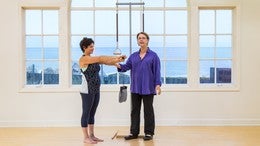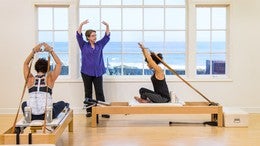Description
About This Video
Transcript
Read Full Transcript
Hi, I'm Rachel Taylor Siegel from the Palladia Center in Boulder, Colorado. And Jen and I are going to show you a little bit of how to balance the shoulder. Similarly to the hips, the when everyone complains about how over developed their quads are and you feel that their upper hamstrings are difficult to engage. Same thing is true with the shoulder. So the pecs get tight and the um, uh, and people complain about their upper traps and then you look at the back of the shoulder and you see that it's soft and it's not as, um, this just the imbalanced area for all of us. And so, um, some of the exercises in pilates that get to the shoulder that are very strengthening for the shoulder be, are more advanced exercises.
And so this thing that we're going to do now is just a little modification of a rowing's. So sometimes people can't sit on the, um, carriage of the reformer because their hip flexors are too tight or because they can't cross their legs because, um, hamstrings are too tight. So we're just gonna do it over here. Um, so Jen's going to have a seat on the short box. It could be a stool, it could be a chair and her spine is going to be up against the um, pole system and her feet are flat and square on the floor. Hip with the part we're going to do. The only odd thing is that I'm going to cross the s the um, the springs and that's partially because I want them to come in the same direction as her forearms and partially because I want them to be a little shorter. So you could also perhaps make them shorter for her depending on what size stool you have. K, the, since we're working on the back of the shoulder and across the upper back in this exercise specifically, we want to keep other joints from bending, um, unduly. So this angle here at the, at the elbow is going to stay approximately the same as it is now.
The risks are going to stay straight and the poems are going to be, um, very wrapped, not gripping, but very wrapped in embracing maybe the w a bar, the wood of the handles so that when she pulls, our goal as the teacher is to get her to pull the springs from the back of the shoulder. So from the shoulder joint itself and her elbows will be wide. It may be in her periphery, depends on how tight your client's justice or your chest is. And so if she keeps this part, uh, this angle about the same, then her elbows are going to come down towards her hips and right and exhale up. And so this isn't going to get any closer, so the hands are going to end up going out ish. Right.
And so what she will feel right and exhale up is a little less than your hands and you don't have to go that far and a little bit. We're just trying to turn it on so that when we do other pilates, reformer, PyLadies mat, it's on for us. And so therefore we'll work better in the other exercises. So you should, you should notice that as she pulls down the springs get tighter and she's inhaling, she should get long between the ribs in the hips and she should feel this and get warmer across the back of the upper arm. Posterior shoulder, which is the rotator cuff across the back of her upper back. Okay. And rest. So we're going to stop Jen here, but then we're going to turn the pepole pole around so that you can see her upper back in the back of her shoulders working in this exercise.
So we've turned her around so you can see her upper back in the back of her shoulders. And what we, uh, hope to see, the thing that tells us that it's right or good productive is that we'll see where her humerus comes in here to the back of her shoulder cuff and we'll see a little dimple, a little shadowing of where the humerus is moving underneath the acromion process. And, um, the night, the cool thing is that, um, the springs get heavier as she goes down and then they lift her up. So she does not have to pick up her own four upper arms, upper arms. And so when that Hap, well she doesn't have pickup per arms at all. And so when that happens, she gets to work the muscles both concentrically as they shorten and also Lee as they lengthen and they really tone and, and um, and they become very accessible then so that when we do other exercises, she can feel them readily. So as she remember that the angle here stays the same and the wrists stay straight and she tries not to pull so much from her fingers as to pull from her body, from her shoulder. So as the elbows come down, the hands will go outwardly a little bit. The palm stay facing forward and exhale up.
And so as she comes down, you'll see this and she's doing great job of keeping her blades from squeezing because not that that's bad or wrong, it's just not what we want. And so she gets this and when she gets this, um, you can, her back does not have to work. And her belly, her upper abs in particular will turn on really beautifully. And so even if she doesn't feel, which is, um, would be kind of amazing, but even if she doesn't feel her posterior shoulder, she will feel it in her upper abs and we'll see it there. And so, and you can rest now Jen and, and so we know we're right. Okay. So there is, so come stand up if you would, and feel your arms now. Yeah. So do you feel very wide open across, oh, come out all the way from the, so you feel there, the result is that you feel wide open across the chest.
The pecs have released, um, out at the edge. At the insertions. Yeah. So that she actually has a, um, a freedom to breathe and a tone, like she's warm here. So the tone from where the pex insert at the sternum all the way out as opposed to just once again strengthening in the same place that, you know, you're always strong, you're already strong, and therefore we're doing more balancing of the body as we want to do in PyLadies k. So in addition, the arms are now being held up more by the shoulder joint, so they're not being, they're not dragging down off of her neck. And so she feels like her arms are lighter, stronger. They, maybe they're more out to the side of her body and she feels, um, a release in her neck, a softness in the neck, maybe even more range when she turns her head. So then we're going to take this prep, this little mini modification thing, and we're going to take it over to the Cadillac and we're gonna look at Swan, at least part of Swan, um, for the same things.
Okay. So here we are on the Cadillac with this, um, push through bar for Swan. I've added the belt since we have it, we might as well use it to help hold her legs down and kind of help her find hamstrings and inner thighs to support her. So as if we are to go up higher than just a small movement. Okay. The arms are straight and this is more challenging because the arms are above her ears. They're behind her head. And um, so already in this position with the wrist straight and the elbow straight is already more challenging and more toning. Okay. So already this muscle is shortened.
So I'm going to ask that Jen and you want to try to keep your, um, palms, let's see, not gripping but um, surrounding like if you could put a piece of paper between your skin and the, um, bar some feeling like that. So you're holding on, you're definitely in control of it, but you aren't grasping or gripping. Okay. Therefore, everything from the palm fingers all the way through to whatever muscles are needed to do this all work in symphony. Um, the way we would like if more full body exercise to be, so I'm going to say it may not be true, but I'm going to ask that Jen start being bent by the spring, not at her elbow, but at her shoulder because that's what we're after at. We're after more strength there and more awareness. So as the spring starts to shorten and push her arms into her, it also has to bend her. And so I'm going to say please bend at your shoulder.
Keep your elbows wide and your wrist straight. That's the hardest part. So as the spring bar comes up, she has this nice strong across the whole, um, from elbow to elbow, like as if she has a push through bar here and it's gonna pick her sternum, her shoulder girdle up, leave your head down, but it's gonna pick her whole shoulder girdle up. And therefore of course her spine and rib cage. And then she's going to be maybe a quality of standing on the bar. So as she returns to the mat, her belly has to pull in to bring the bar down.
She changes her head to other side, wrists and elbows are high and she straightens her arm. Part of her pushes through this way and part of her this spring is pushing her arm into her shoulders. So never in this exercise, does she not work here? Some amount. All right, so as she starts again with the wrist straight, will you be brave and try it with your thumb, with your fingers? Since I have the bar. Okay. So the spring bar push it. Nope. Pushes her straight arm into her shoulder, which tones her upper abs right off the bat. And my be able to see that in film. And then she's going to bend here and here and that's going to keep her wide and high straight and tone her whole upper back, which is going to pick her sternum up with her blades so that her whole girdle head is down, spine is flexed, but the blades are not necessarily squeezing.
Then her nose dive down and she turns to her right cheek, but she's hand standing on the bar. So it's still supporting her as she starts to straighten, she intends to push through, but she also is being pushed into and therefore all the muscles are toned the whole way across and even into her belly. So if we were to go higher and we can go as high as you like, the same thing is the case. So we could put a piece of paper between your skin and the um, handles. What would that feel like? Yes. Nice. And then the shoulders bend in the elbows, been her control of that and she doesn't squeeze and cave.
She stays with her weight on the spring bar. It lifts her hands and her whole arm, she stands on it as she continues up, elbows wide, and she not only pushes it or is lifted by it, I'm going to say, but she also pulls it into her and the strap is holding her down. So or so as has something against which to support her spine. And she has enough to clench her butt and beautifully done. And then she can have vendor's shoulders first nose dive down for the upper abs, wrist up, Aha, wrist up.
[inaudible] as she pushes through, changes her head to the other side, wrist up, right. Only because, not that it's terrible, but if she drops her wrists, she loses her shoulder. And so since the whole point of doing this is to strengthen her shoulder and upper back, then that's an important, uh, piece of it. Okay. Let's do it one more time. What'd you Jen? All right. So, um, from her straight arms, the spring is already pushing into her, right? And it's already toning her torso. She bends here and here she swivels.
Like the bar swivels in her hand, her humerus bone swivels in her shoulder, picks up her sternum, she handstands upon the bar, doesn't push it up because it's doing the pushing up itself and therefore she pulls it into her, maybe pull it into a little bit more, right so that her tummy tones and supports her spine. And then she knows dives over elbows, high and wide, palms, wrists up, pull down, gives her her belly and as she pushes through she stays connected back in here. And I've got the bar and you can come in and sit back on your hips. Good. And then come stand up for just a brief moment and let's see how you feel.
I feel good. Right? So you feel open and strong. She's really hot back here, which tells us that she worked at the back of her arm, across her upper back between our blades and through, and you can feel that she's erect on, on her spine and on her pelvis without sticking your chest out or, you know, arching her back on purpose to look that way. But she just naturally organized in gravity to feel yeah. To feel good, which is what we want anyway. Okay. So that, that's a way to balance the shoulder from the palm all the way through and feel that strength in the upper back.
That's going to keep us from here to here without faking it or overdoing it. Thanks.
Comments
Thank you for watching! Rachel
You need to be a subscriber to post a comment.
Please Log In or Create an Account to start your free trial.













